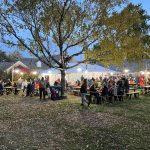Snapshots in Analog
By Blaine Schultz
To quote the Velvet Underground, “those were different times”…
It’s real easy to not get misty-eyed about the old days. Before desktop publishing and 24-hour Kinko’s became commonplace, crude music fanzines and gig posters were laid out by hand and mimeographed. Before laptop home studios and Gap ad campaigns, you could get beat up for throwing original music in the face of the bar band status quo. Bands actually put out their own albums… wait a minute, we’re back to that one.
In the late 1970s, the term “Rustbelt” was coined to describe all the manufacturing jobs exiting cities like Milwaukee. But true to its European artistic roots, young bands exploding with original music made sure they had venues to perform in. There really were no rules, maybe just a few role models like the Beats or the Stooges or the Ramones. DIY was not an option, it was the lone muddy trail.
So before you groan about the lack of a local music scene, take a look at these folks. Like Crispus Attucks, they were the first. Before punk turned into new wave turned into MTV/college/indie turned into alt-country, there were no lines to blur. Everything was a blur. A real cool blur.
Ken Baldwin
Drummer Ken Baldwin ran the Starship, a club on 4th and Wisconsin that followed Zak’s as Milwaukee’s top club for live original music. The Starship was a disco, pool hall and a watering hole for hookers and businessmen. Buddy Jim Richardson managed the Voom Voom Room, played drums in Death, Milwaukee’s first punk band, and later with power pop legends The Shivvers.
Jerome Brish(a.k.a. Presley Haskel)& Richard LaValliere
With the Haskels, and later LaValliere with the Oil Tasters, these guys were two of the city’s musical visionaries. Haskel fronted groups until his untimely murder in 1991. LaValliere lives in Brooklyn, New York.
Shepherd Express A&E Editor Dave Luhrssen was a young writer on the music scene in those days. “Jerome Brish was a talented songwriter, but his greatest skill was to imagine that a punk-rock scene could exist in Milwaukee and then to make it happen. He had business sense and people sense along with musical ability. It was Jerome who talked Damian Zak into transforming his club into Milwaukee’s CBGB. But the Haskels wouldn’t have been as interesting without Richard LaValliere, whose songs and slightly wacky stage presence added an arty, surreal edge to the proceedings.
“Haskel Hotel was a big old four-unit house on Arlington. They rehearsed in the basement and had parties upstairs that drew all the scenesters. Haskel Hotel was almost as much a hub for punk rock in the early days as Zak’s. There have been many band houses since, but history conspired to make Haskel Hotel especially important; it was on the sharp edge of a movement that seemed as if it would become large and important, earth-shattering.”
Mike Hoffmann
From the big leagues with Yipes! to EIEIO’s pre alt-country, to his current work with Freshwater Collins, guitarist/producer Mike Hoffmann has never sat idle for long. Around the time he was recording Semi Twang’s album in Los Angeles, he also walked the plank with Cherry Cake. Seeing them open a BoDeans Summerfest gig to a crowd of perplexed flatlanders with a jagged version of Fleetwood Mac’s “Go Your Own Way” remains a pleasant memory.
Plasticland
Plasticland have always been a band without a time. Looking back, the idea of playing psychedelic music in post-punk times might seem like genius. These guys never thought twice about it. Frontman Glenn Rhese’s Carnaby sneer and bassist John Frankoc’s pure glee set the band’s personality. Guitarist Dan Mullen packed a nugget-sized wallop and drummers Lady DuBlonnet, Vic Demechi and Rob McCuen kept the big beat. Oh yeah, don’t forget the clothes.
According to local music legend and Plasticland friend Voot Warnings, “With Plasticland, gigs were often special events. One time at Summerfest, Glenn came out dressed like a Pope – well maybe not a Pope, but he wore a big religious-looking hat. Another time, the audience was invited to paint the band with black light paints while they played.”
Die Kreuzen
When all is said and done, Die Kreuzen might be the most influential band to come out of Milwaukee. From their thrash hardcore beginnings, they ultimately became something unique. The ingredients were simple, slamming together a flannel-shirted Midwest work ethic and ideas that grew more muscular and arty as time went on.
According to local music historian Lars Kvam, “Die Kreuzen was one of the first hardcore bands in Milwaukee. They played loud, fast and hard. And they coincided with the skate punk scene. You take hardcore for granted today, but back then no one was rocking out – everyone was into this post-punk horseshit. Die Kreuzen were the Godfathers of Milwaukee hardcore punk.”
Boy Dirt Car
Based around the duo of Eric Lunde and Darren Brown, BDC created a clanging, droning way to make music. While name-checked as contemporaries by leading lights Einstürzende Neubauten, BDC eventually found a burgeoning scene of imposters latching onto the “noise thing” bandwagon. Was BDC a band or an art project? It hardly matters, but you can find out for yourself if rumors of new recordings prove true.
Dave Szolwinski played with BDC and fronted his own tribal/noise/rock group, FuckFace. He also owned Earwaves, a record store specializing in high energy rock & roll, free jazz and collectibles.
“A big part of BDC was the idea that anything could happen,” says Szolwinski. “It was improvisation, but it followed Eric and Darren. After a while a lot of rich kids picked up on that kind of music, but you could tell it wasn’t genuine.”
Liquid Pink
Liquid Pink had the dual advantages of living in the same house and having a manager with a grasp on reality. An album recorded in a legitimate studio and a clutch of other tracks is the legacy of this band who knew exactly what it was about – chiming pop hooks a la Big Star, the open-minded sonic view of the Velvet Underground and the crunch of the early Who. The band’s personality drew from Peder Hedman’s songwriting as much as the tension among its members. Bassist Dale Kaminski was as easy-natured as drummer Rob McCuen was volatile. Keyboardist Julie Neidzieko’s talent brought another layer to the music. I have not had a favorite band since Liquid Pink called it a day.
Dummy Club
Dummy Club took inspiration from the rock & roll twilight zone of the 1950s, where Frederick’s of Hollywood meets Ed Wood and the Shangri Las on a dead-end street. Bassist Steve Shrank is one of Milwaukee’s unsung rock & roll heroes, having played with Voot Warnings’ Fresh Sounds
and Love Bully, among others. “I remember one summer when the Dummy Club’s shows got shut down by the cops four weekends in a row. Fights always seemed to break out whenever we played “The Crusher,” a song about the Bay View wrestler Reggie Lisowski. I always felt, and still do, that the Dummy Club was one of the greatest rock & roll bands ever.”
New Community Co-op
“Club owners seemed to have some crazy idea that if the bands didn’t bring paying customers, they would go out of business. We took the position that the club owners were greedy and short-sighted, and we vowed to cut out the middlemen and put on our own shows. We rented the hall at Club Garibaldi in Bay View, and later moved to Vitucci’s on North Avenue.”
In the summer of ’87, Vitucci’s remodeled and the Co-op was left venue-less. At its peak, about 25 bands were members, including Bedrock, Blowtorch, The F.S. Camels, Dear John, F/I, Jackdaws, Johnny and the Losers, Joker’s Henchmen, Oral Groove Dog, Roach Motel, Squares, Three on Fire, Umbrella Man and Your Mood Merchants.
“Perhaps the biggest impact of the Co-op was that it helped create the Newsletter, one of the few publications in Milwaukee’s history to focus almost exclusively on local music,” says Wooldridge. “Jim Warchol, Beth Schaefer, myself, Gina Newman, Blaine Schultz, Deone Jahnke, Dan Franke and many others… all played significant roles.
During its four-year run, we saw many good bands come and go, but we never saw any effort quite as unselfish and committed to the local scene as the New Community Co-op.” Wooldridge now lives in Minneapolis and plays with the Wooldridge Brothers.
To see the photos from this article, please <a href=” http://www.vitalsourcemag.com/gallery/snapshotsinanalog “>click here</a> to visit our photo gallery. They’re kind of important to the story, plus they’re full of 80s fashion and testosterone-fueled DIY angst.














